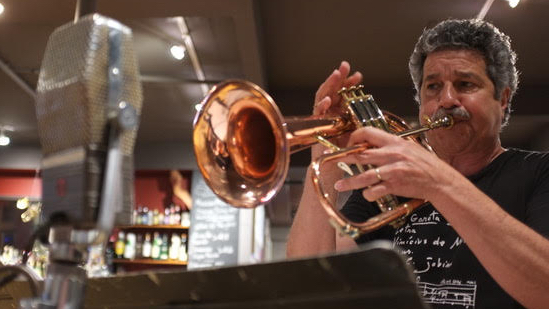  | |||
 | |||

Trumpeter Mark Morganelli is one of those musicians who took the bold step of peering beyond his own performing career arc to present the music he loved for audiences. I can fondly recall visiting his former Jazz Forum space on Broadway, one of the so-called “loft” spaces that proved to be so vital for live jazz presentation in the 70s and 80s, and flopping down on one of his couches to catch a performance. Now celebrating 40 years of his Jazz Forum Arts presenting organization, I recently posed some questions to this intrepid fellow jazz presenter…
1. Talk about your evolution from musician to presenter and what compelled you to establish stages to present jazz.
In 1975 I lived at the Creative Arts House on the campus of Bucknell University, Lewisburg, Pennsylvanie during my sophomore and junior years at school. Having recently switched from being a Chemistry Major to a Music Education degree, I began presenting “Coffeehouses,” as we called them, featuring several musical genres performed “live”in our (not so) elegant basement space. These presentations were often accompanied by an art exhibit and sometimes a poetry reading. Hey – you gotta start somewhere!. After performing on the road for the first year out of Bucknell, I moved into New York City, performing in various clubs and other venues. I soon moved out of my small, though centrally located, Greenwich Village apartment into a much more spacious loft in the East Village. The third floor space at 50 Cooper Square was fabulous to rehearse my big band in 1978 and ’79, and then I thought I’d feature other deserving, talented emerging and established artists starting in June, 1979 – hence, the first Jazz Forum performance space was born.
2. What was your experience presenting (and playing) performances at your former Jazz Forum “loft” space on Broadway, and what did you learn from that experience?
After a year and a half at 50 Cooper Square, my landlord, Leonard Stern informed me and all the other tenants that he would not be renewing leases. He actually bought the Village Voice newspaper and moved their offices to what had been our building. So, after a legal settlement, I took some meager funds, borrowed more and expanded operations to a 5,000 square-foot fifth floor loft at 648 Broadway, near Bleecker Street. We didn’t miss one weekly jam session in the month-long transition, then opened a seven-night-a-week performance space. The first artists at the new loft included Bob Berg and the Tom Harrell Quintet featuring Al Foster, and Frank Foster’s Non-Electric Company big band. I also had an opportunity to perform at both lofts, culminating in my first “live” recording, September 5, 1982 as part of the first annual Greenwich Village Jazz Festival. That second loft featured performances by Barry Harris, who also taught at both Jazz Forum lofts for three years before he started his own Jazz Cultural Theatre. We also had many memorable nights, listening to Art Blakey, Jaki Byard, Charli Persip, Philly Joe Jones, with Wynton Marsalis sitting in, and “live” recordings there by Woody Shaw and Bobby Hutcherson, and Red Rodney and Ira Sullivan. It was May, 1981, just after opening, that I featured Tommy Flanagan and Barry Harris, performing on two Steinway grand pianos, with Dr. Art Davis, bass and Leroy Williams, drums. That concept still lives on, with contemporary performances by Bill Charlap and Renee Rosnes at our Jazz Forum, Tarrytown. every Winter.
3. What compelled you to start Jazz Forum Arts and how did you go about entering the broader world of jazz presenting beyond that Jazz Forum space?
Owing my landlord one month’s rent, I asked Art Blakey and Wynton Marsalis to lend me three month’s rent, but the landlord would not accept it, and summarily evicted me. I resurfaced the next night, presenting with Art D’Lugoff at his esteemed Village Gate. Later that year, 1983, I re-met Ellen prior at our tenth high school reunion in Glen Head, Long Island. We hit it off, and I moved to her apartment on the Upper West Side. I attended a meeting of the Friends of Riverside Park, and asked Park Director Charles McKinney why he didn’t do jazz in Riverside Park. He responded, “Why don’t you do jazz in Riverside Park?!” That directly led me to form the not-for-profit arts presenting organization, Jazz Forum Arts to present the annual Riverside Park Arts Festival, an annual free summer concert series that lasted thirteen years from 1985-1997.
4. In your forty years of Jazz Forum Arts, what are some of the most valuable lessons you might share with those who may be contemplating presenting arts performances?
Performing and presenting are two different things, though obviously related. The most important thing, in my view, is to have a clear vision, a solid team, and most important, funding. I have spent many hours of the past forty years as a development professional, constantly raising money, establishing sponsor relationships and cultivating audiences. The only constant is change. Sponsors, patrons and supporters come and go, so you have to be extremely flexible and resilient in the face of perceived adversity. After 9/11, I say it’s only music. That said, I’ve devoted almost fifty years of my life to the high-level presentation of music, especially jazz.
5. What will the next forty years of Jazz Forum Arts look like as you gaze into the future?
Jazz Forum Arts is now in better shape than ever. We have a great team, both organizationally, administratively, and with empathetic and supportive staff at the club and seasoned crew for our free outdoor summer concerts. We’ve also added major educational components to our programming, cultivating the audiences of the future – now!

